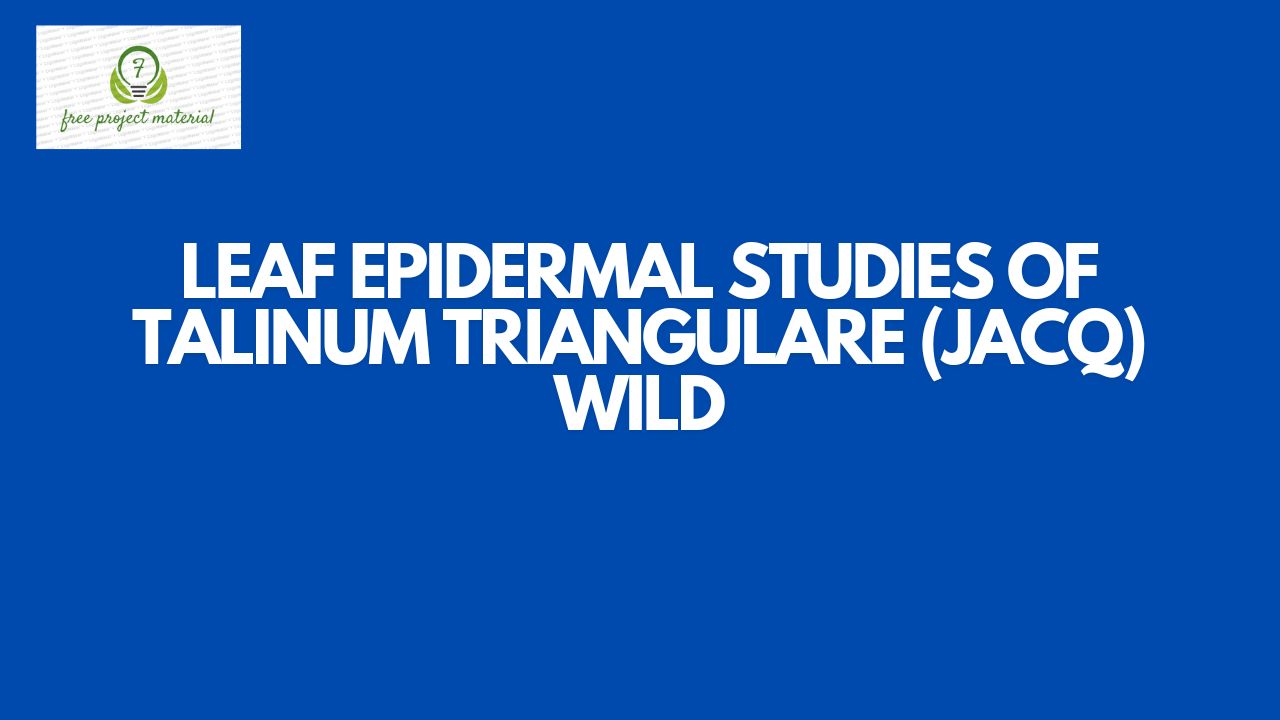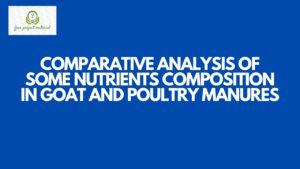ABSTRACT
The structure of stomata in Talinum triangulare were examined to determine the development pathway of stomata in the leaves. Mature leaves were peeled, stained with safranin–o and examined under the microscope. Clear photo-micrographs were taken with binocular research microscope (Amscope) filled with Amcope digital camera. The mature stomata were paracytic in nature. The stomata distribution was amphistomatic. The anticlinal walls of the mature leaves were undulate on both abaxial and adaxial surfaces. The epidermal cell shapes were irregular on both surfaces. These features could serves as an important taxonomic tool in delimiting the spaces.
TABLE OF CONTENTS
Title Page – – – – – – – – – i
Certification – – – – – – – – ii
Dedication – – – – – – – – – iii
Acknowledgements – – – – – – – iv-v
Abstract – – – – – – – – – vi
Table of contents – – – – – – – – vii-viii
CHAPTER ONE: INTRODUCTION
1.1 Background of the Study – – – – – – 1-2
1.2 Aim and Objective of the Study – – – – – 2
1.2.1 Aim of the Study – – – – – – – 2
1.2.2 Objectives of the Study – – – – – – 2
1.3 Scope and Limitation of the Study – – – – 3
CHAPTER TWO: LITERATURE REVIEW
2.1 Classification of Plant – – – – – – 4
2.2 Botanical Description of Talinum triangulare – – 4-6
2.3 Proximate Composition and Mineral Content
of T. triangulare – – – – – – – 6
2.4 Enthobotanical Importance of Talinum triangulare – 6-7
2.5 Chemical Composition of Talinum triangulare – – 7-8
2.6 Nutritional Values of Talinum triangulare – – – 8
2.6.1 Culinary Values – – – – – – – – 9
2.6.2 Antioxidant Properties – – – – – – 9-10
2.6.3 Supports the Liver – – – – – – – 10
2.6.4 Waterleaf is Good for Pregnant Women – – – – 10
2.6.5 Enhances Cerebral Functioning – – – – 11
CHAPTER THREE: MATERIALS AND METHODS
3.1 Materials – – – – – – – – 12
3.1.1 Collection of Plant Sample – – – – – 12
3.2 Methods – – – – – – – – 13
3.2.1 Sample Preparation – – – – – – 13-14
CHAPTER FOUR: RESULTS AND DISCUSSION
4.1 Results – – – – – – – – 15
4.2 Discussion – – – – – – – – 16-17
CHAPTER FIVE: CONCLUSION AND RECOMMENDATIONS
5.1 Conclusion – – – – – – – – 18
5.2 Recommendations – – – – – – – 18
References
CHAPTER ONE – INTRODUCTION
1.1 Background of the Study
Taxonomic studies of the genus Talinum have been carried out to an extent based on morphology and leaf anatomy (Nyananyo and Olowokudejo, 1986; Swarna and Ravinthran, 2013), Phytochemical analysis (Aja et al., 2010) and molecular characterization, particularly on T triangulare. Also, leaf architecture as a systematic tool in the identification of angiosperms is vital in species study (Dilcher, 1974; Metcaife and Chalk, 1979). The taxonomic valves of stomatal ontogeny, Stomatal types and epidermal features are characteristic to some families, subfamilies and general (Abubakar et al., 2011). These have been largely employed in taxonomic classification.
Stomatal characters such as number, type, size, shape and orientation of the guard cells to the subsidiary cells are paramount to taxonomic studies (Das, 2002). Despite the occurrence of different foliar stomata types in specific and intraspecific levels, some plant species have only one stomata on their leaf surfaces (Ekeke and Agbagwa, 2015)
Although the epidermal features of T. triangulare have been observed, there seems to be no report on its developmental process. Considering the significance of stomatal ontogeny and other epidermal features, this work was aimed to examine the epidermal features of T. triangulare and to add information on the existing data that will further delimitation of this species among other members of the genus Talinum.
1.2 Aim and objectives of the study
1.2.1 Aim of the study
The Aim of this work is;
- To assess some diagnostic features that will aids in the identifying and describing of Talinum triangulare.
1.2.2 Objectives of the Study
The main objective of this work is;
- To determine epidermal features of Talinum triangulare on the both adaxial and abaxial surfaces.
1.3 Scope and Limitation of the Study
The scope of this research work covered leaf epidermal characters of Talinum triangulare due to ethnicity problem in country.



